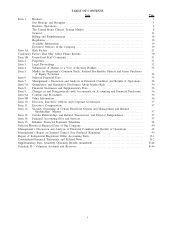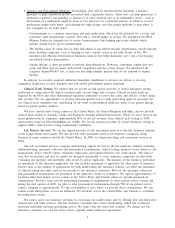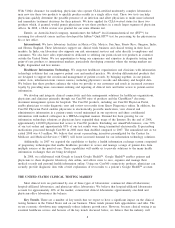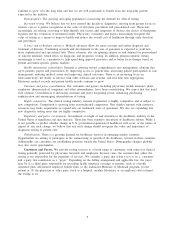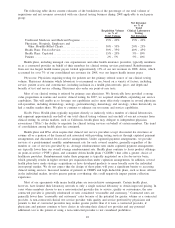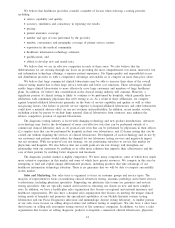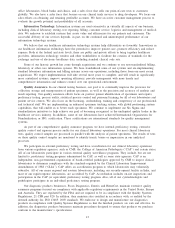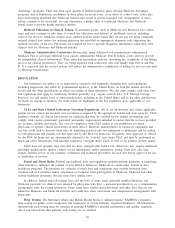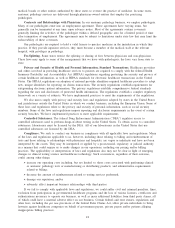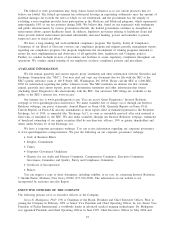Quest Diagnostics 2008 Annual Report Download - page 21
Download and view the complete annual report
Please find page 21 of the 2008 Quest Diagnostics annual report below. You can navigate through the pages in the report by either clicking on the pages listed below, or by using the keyword search tool below to find specific information within the annual report.continue to grow over the long term and that we are well positioned to benefit from the long-term growth
expected in the industry.
Demographics. The growing and aging population is increasing the demand for clinical testing.
Increased testing. We believe that we have entered the decade of diagnostics, moving from greater focus on
curative care to a greater recognition of the value of detection, prevention and personalized care. Physicians
increasingly are relying on testing to help identify risk factors and symptoms of disease, the choice of therapeutic
regimen and the evaluation of treatment results. Physicians, consumers and payers increasingly recognize the
value of testing as a means to improve health and reduce the overall cost of healthcare through early detection
and prevention.
Science and technology advances. Medical advances allow for more accurate and earlier diagnosis and
treatment of diseases. Continuing research and development in the area of genomics is expected to yield new,
more sophisticated and specialized tests. These advances also are spurring interest in and demand for personalized
or tailored medicine, which relies on diagnostic and prognostic testing. In addition, pharmacogenetic testing
increasingly is used as a parameter to help speed drug approval processes and to better focus therapy based on
patient and tumor-specific genetic markers.
Health information technologies. Demand is growing toward comprehensive care management solutions that
serve patients, payers and practitioners by improving access to patient data, increasing patient participation in care
management, reducing medical errors and improving clinical outcomes. There is an increasing focus on
interconnectivity, the ability to interact with other software and systems, and real time data aggregation.
Electronic medical records and patient health records continue to grow.
Customer and payer consolidation. Our customers and payers, including physicians, health insurance plans,
employers, pharmaceutical companies and other intermediaries, have been consolidating. We expect that this trend
will continue. Consolidation is increasing customer and payer bargaining power, enhancing purchasing
sophistication and encouraging internalization of testing.
Highly competitive. The clinical testing industry remains fragmented, is highly competitive and is subject to
new competition. Competition is growing from non-traditional competitors. New market entrants with extensive
resources may make acquisitions or expand into our traditional areas of operations. We also are expanding into
new diagnostic testing areas that are highly competitive.
Regulatory and policy environment. Government oversight of and attention to the healthcare industry in the
United States is significant and may increase. There has been extensive discussion of healthcare reform. While it
is not possible to predict whether change in U.S. government regulation of healthcare will occur, or the nature or
impact of any such change, we believe that any such change should recognize the value and importance of
diagnostic testing to patient care.
Globalization. There is a growing demand for healthcare services in emerging market countries.
Opportunities are arising to participate in the restructuring or growth of the healthcare systems in these countries.
Additionally, our customers are establishing positions outside the United States. Demographic changes globally
may also create opportunities.
Customers and Payers. We provide testing services to a broad range of customers, with orders for clinical
testing generally generated by physicians, hospitals and employers. In most cases, the customer that orders the
testing is not responsible for the payments of services. We consider a party that refers a test to us a “customer”
and a party that reimburses us a “payer.” Depending on the billing arrangement and applicable law, the payer
may be (1) a third party responsible for providing health insurance coverage to patients, such as a health
insurance plan, self-insured employer benefit fund, or the traditional Medicare or Medicaid program, (2) the
patient or (3) the physician or other party (such as a hospital, another laboratory or an employer) who referred
the testing to us.
9


